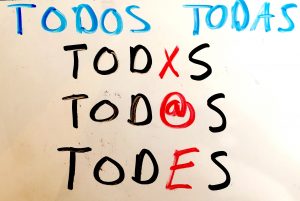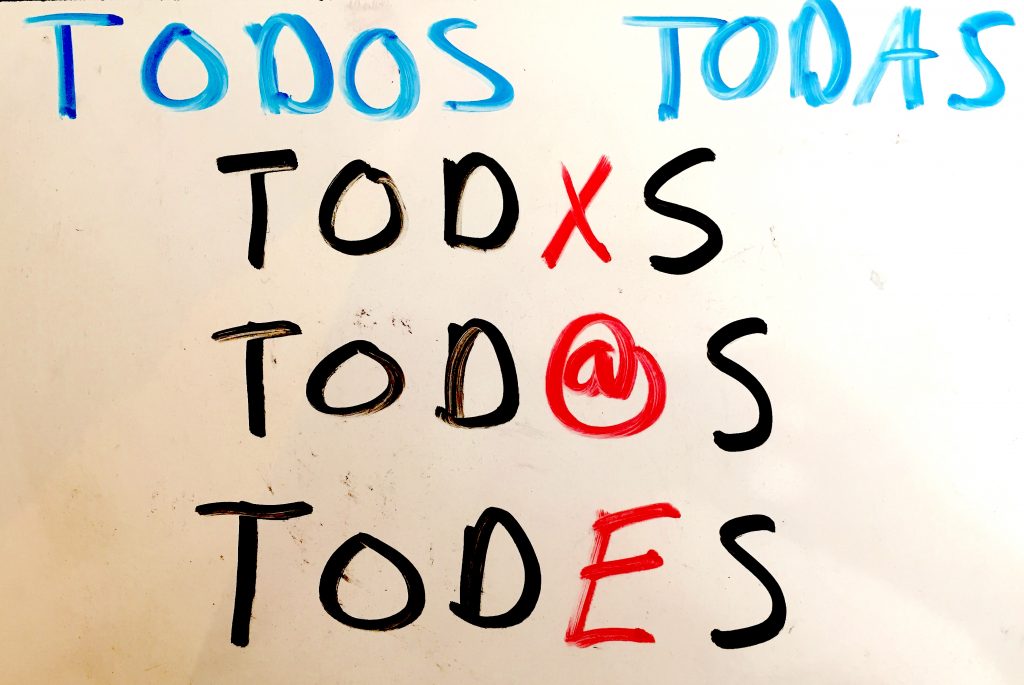In this article we are delving into the current trend of using the inclusive language in Spanish: El lenguaje inclusivo.
Language is always evolving and often reflects societal trends and tendencies. Let’s take for example these new verbs:
- I already Googled that
- Let’s Skype
- Whatsapp me
- We SnapChatted
These verbs did not exist 5,10, 20 years ago and now they are used in certain segments of society on a daily basis. The same holds true for parts of speech that evolve as societal trends emerge.
Traditionally, the Spanish language, as is true with other Romance languages was (and still is officially) considered a binary language; meaning that only the masculine and feminine genders are reflected in articles, adjectives, and other parts of speech. In this article we examine the current linguistic trend of using inclusive language or lenguaje inclusivo when addressing or talking about people.
What is the inclusive language in Spanish?
As you may know, the gender neutral in Spanish is the same as the masculine gender, however, recently there are some sectors of society that are starting to use what they call “lenguaje inclusivo” or inclusive language in Spanish to create a differentiation between the masculine gender and the neutral gender.
Let’s look at this example of how the masculine gender is used to express the gender neutral:
- Todos los niños van a ir a la cafetería en 20 minutos.
Now any Spanish speaker or one who has studied Spanish probably knows that todos los niños most likely refers to a mixed gender group of male and female children.
Presently, this new language style is not yet accepted by the Spanish Royal Academy, however undeniably its use is gaining more followers especially among teenagers, feminist groups, LGBTQ groups, gender-fluid people, and people who think the Spanish language needs this gender differentiation from the masculine one to reflect equality and diversity.
What’s the problem the inclusive language is trying to solve?

Amongst these groups, some say the inclusive language is actively trying to eradicate the “sexist and male-oriented use of the natural languages” by giving visibility to all present identities (male, female, gender fluid, etc.)(Benegas, 2018).
This is the reason why you find some vowels replaced by a “@” or an “x” and, more recently, by an “e”, at the end of the words.
Let’s see some examples of the lenguaje inclusivo:
- Todos
 (everyone / everybody) could be changed to “Tod@s”, “Todxs”, and “Todes”
(everyone / everybody) could be changed to “Tod@s”, “Todxs”, and “Todes” .
. - Chicos (including boys and girls): “Chic@s”, “Chicxs”, and “Chiques”
 .
. - Bienvenidos (welcome): “Bienvenid@s”, “Bienvenidxs”, and “Bienvenides”
 .
.
Another option, is using the asterisk to replace the vowel. This was an earlier strategy to incorporate more gender-neutral language, but other options are gaining in popularity. It looks like this:
Examples:
Tod*s, chic*s, and bienvenid*s
The options that use “@”, “x” and “*” don’t have a proper pronunciation, they are only used in writing, while the last option that uses “e” does have a proper pronunciation so it’s used both in written and spoken language.
Now, let’s see some real life examples:
-
- Bienvenides, egresades (Welcome, graduates)
 : this option is gaining acceptance in academia since the neutral gender option “Bienvenidos, egresados” only represents male graduates.
: this option is gaining acceptance in academia since the neutral gender option “Bienvenidos, egresados” only represents male graduates. - Abiertas las inscripciones de fútbol para niñes
 (Football for Children Registration Now Open): This way you would know the registration is open for both boys and girls. It could be to create a mixed team or two teams (one for boys and one for girls) but you’ll be sure it is open for both genders. If you use the neutral gender form “Abiertas las inscripciones de fútbol para niños”, it’s not clear if you are referring to boys and girls or only boys.
(Football for Children Registration Now Open): This way you would know the registration is open for both boys and girls. It could be to create a mixed team or two teams (one for boys and one for girls) but you’ll be sure it is open for both genders. If you use the neutral gender form “Abiertas las inscripciones de fútbol para niños”, it’s not clear if you are referring to boys and girls or only boys. - Todes están invitades a la fiesta de graduación
 (Everyone is invited to the graduation party): Again, using the “e” instead of the “o” clarifies that everyone is invited, not only males.
(Everyone is invited to the graduation party): Again, using the “e” instead of the “o” clarifies that everyone is invited, not only males.
- Bienvenides, egresades (Welcome, graduates)
Critics and Opponents
As I mentioned before, The Spanish Royal Academy (Real Academia Española) rejects the use of the inclusive language but eventually had to admit that in some specific cases, the masculine plural used as neutral gender does not clearly reflect the existence of both genders (as in the example above), therefore it’s recommended to use unfolded forms (fórmulas desdobladas) of gender in Spanish (2009).
I know you are wondering what the unfolded forms are. Let’s see some examples:
- El profesorado:
 it means a group of teachers
it means a group of teachers
- Neutral gender form: Los profesores
- Unfolded form: Los profesores y las profesoras
The Spanish language rule says the two first forms are correct, while the last one is considered “contrived and unnecessary” (Real Academia Española, n.d). However, they recommend its use when the neutral gender form doesn’t clearly represent both genders.
Following the last example, let’s say a newspaper publishes a news story about a teacher’s protest. It says:
Los profesores protestan y exigen un aumento de sueldo ![]() (Teachers protest and demand a raise): in this case, it could means all teachers are protesting or all male teachers are protesting. So, to make it clear, the Royal Academy recommends using the unfolded form in this specific case because the neutral gender form is not explicit enough about the gender of the subject (los profesores):
(Teachers protest and demand a raise): in this case, it could means all teachers are protesting or all male teachers are protesting. So, to make it clear, the Royal Academy recommends using the unfolded form in this specific case because the neutral gender form is not explicit enough about the gender of the subject (los profesores):
- Unfolded form: Los profesores y las profesoras protestan y exigen un aumento de sueldo.
 This is the form they prefer over the inclusive language.
This is the form they prefer over the inclusive language.
Why not use “el profesorado” instead? Because profesorado also means a teaching job and a teaching degree, so it is less clear than the other two options:
- El profesorado protesta y exige un aumento de sueldo:
 Who are protesting? The teachers or the students who are pursuing a teaching degree?
Who are protesting? The teachers or the students who are pursuing a teaching degree?
Then, what is the option the inclusive language proposes? Simple: just change the vowel in the article.
Some society sectors claim the inclusive language is needed to make the Spanish language more representative, and it only means a change in some structures without affecting it negatively, while other sectors, usually those who are considered more purists and rigorous with the language, tend to reject the use, saying it represents a danger for the language since it changes all its structure and could make it disappear (“Qué es el lenguaje inclusivo y por qué algunos lingüistas están a favor”, 2018).
Final Comments
Inés Fernández-Ordoñez, the youngest member of the Spanish Royal Academy points out that even when it’s difficult to restructure a language, those who propose to change it should be respected because a using language supposes a permanent change and society should be open to it (2012).
Since language in general is modified over time and according to society needs, it is possible the use of the lenguaje inclusivo continues to gain followers and will be accepted by the Academy in the future. For now, its use is recommended only when requested or if you feel it needs to be used in certain situations when the masculine gender as in neutral gender doesn’t represent all people in the context.
Note: If you want some extra information about this topic, feel free to download the lesson notes!
¡Ahora es tu turno! / Now It’s Your Turn!
- What do you think about the inclusive language?
- Is it difficult to apply in your own classrooms?
- Is it difficult to change the “o” to “e” when writing or speaking?
- What do your students say about it?
Share your comments below or in our Facebook group to talk about this with other teachers and to receive feedback from other Spanish teachers!
Citations:
- (2018, June 18). Qué es el lenguaje inclusivo y por qué algunos lingüistas están a favor. La Nación. Retrieved from https://www.lanacion.com.ar/2145251-que-es-el-lenguaje-inclusivo-y-por-que-algunos-linguistas-estan-a-favor
- Benegas, L. (2018, June 29). Lenguaje inclusivo: ¿un nuevo género o moda pasajera? Retrieved November 2, 2018, from https://www.infobae.com/parati/news/2018/06/29/lenguaje-inclusivo-un-nuevo-genero-o-moda-pasajera/
- Fernández-Ordóñez, I. (2012, March 8). El español y la igualdad real de los sexos. Retrieved November 2, 2018, from https://www.elcultural.com/noticias/letras/El-espanol-y-la-igualdad-real-de-los-sexos/2893
- Lenguaje no sexista – Wikipedia, la enciclopedia libre. (2018, October 29). Retrieved November 2, 2018, from https://es.wikipedia.org/wiki/Lenguaje_no_sexista
- Real Academia Española. (n.d). Los ciudadanos y las ciudadanas, los niños y las niñas | Real Academia Española. Retrieved 2 noviembre, 2018, from http://www.rae.es/consultas/los-ciudadanos-y-las-ciudadanas-los-ninos-y-las-ninas
- Real Academia Española. (2009). Nueva gramática de la lengua española. Retrieved from http://www.rae.es/sites/default/files/Sala_prensa_Dosier_Gramatica_2009.pdf






En primera instancia, les felicito por el trabajo que hacen día a día. Se ve que le ponen mucho empeño y eso se nota.
Bueno, yo opino que en español no existe el genéro neutro o inclusivo, ya que la marca de género masculino sustituye aquellos dos últimos.
Es por eso, que algunas personas estamos considerando usar nuevas alternativas para darle lugar a la inclusión y a la igualdad.
Si usted es hablante nativo del inglés y está aprendiendo español, notará que hay un componente sexista muy marcado en esta última lengua, sobre todo en aquellas palabras que hacen referencia a seres humanes.
Saludos a todes les estudiantes que hayan leído este comentario.